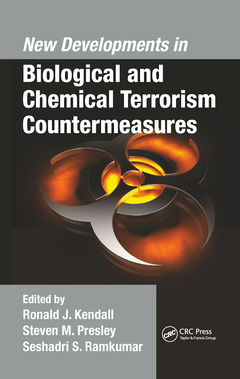Description
New Developments in Biological and Chemical Terrorism Countermeasures
Coordinators: Kendall Ronald J., Presley Steven M., Ramkumar Seshadri S.
Language: English
Subjects for New Developments in Biological and Chemical Terrorism...:
Keywords
Middle East Respiratory Syndrome Coronavirus; Omsk Hemorrhagic Fever Virus; Western Equine Encephalitis Virus; Rift Valley Fever Virus; Venezuelan Equine Encephalitis Virus; Biological Threat Agents; Chemical Threat Agents; Fuzzy Logic Relationships; Eastern Equine Encephalitis Virus; EMI Shielding; Swine Fever Virus; Feral Swine; Chemical Terrorism Countermeasures; Superhydrophobic Surfaces; Peanut Lectin; Threat Agents; Display Phage; UV Protection; Coli K12 Strain; Lubbock County; Castor Seed; Infectious Disease Agent; Normal Flora; Functional Clothing; EHDV
Publication date: 03-2021
· 15.6x23.4 cm · Paperback
Publication date: 02-2016
· 15.6x23.4 cm · Hardback
Description
/li>Contents
/li>Biography
/li>
A science-based text, New Developments in Biological and Chemical Terrorism Countermeasures presents research that addresses the growing threat of chemical and biological terrorism as well as the need for improvements in the implementation of countermeasures. This new textbook building upon Advances in Biological and Chemical Terrorism Countermeasures is the product of more than a decade of synthesizing newly acquired information through extensive research and development supported by the United States Army through Texas Tech University?s Admiral Elmo R. Zumwalt, Jr. National Program for Countermeasures to Biological and Chemical Threats.
The book describes and expands upon threats, vulnerabilities, and pathogenic and toxic effects associated with agents used in biological and chemical terrorism. Among the discussions of agents is an exceptionally thorough examination of ricin history, toxicity, adsorption, and mobility. It also gives an overview of protective gear and in-depth perspectives on future research needs, including identifying challenges and paths forward in predicting risks.
Effective countermeasures to biological and chemical threats are becoming increasingly necessary. New Developments in Biological and Chemical Terrorism Countermeasures provides a cutting-edge source addressing and advancing this need. It offers strategies and expert viewpoints toward improving defenses against threats in the United States as well as other nations.
State of the Science: Background, History, and Current Threats. Challenges and Paths Forward in Predicting Risk of Vector-Borne Diseases: From Mechanistic to Rule-Based Modeling Frameworks. Threats and Vulnerabilities Associated with Biological Agents. Pathogenic and Toxic Effects of Biological Threat Agents. Ricin History, Toxicity, Adsorption, Mobility, and Palliative Actions. Display Phage Therapy: Development of a Probiotic Biotherapeutic for Countermeasures against Cholera Toxin. New Perspectives on Protective Fibrous Substrates. Conclusions and Research Needs for the Future.
Ronald J. Kendall is a professor of environmental toxicology at Texas Tech University (TTU), Lubbock, and is leading a new major initiative in wildlife toxicology. He is director emeritus and founding director of The Institute of Environmental and Human Health (TIEHH), a joint venture between TTU and the TTU Health Sciences Center. He was also the founding department chair of the Department of Environmental Toxicology at TTU. For over a decade, he has served as Principal Investigator of the Admiral Elmo R. Zumwalt, Jr. National Program for Countermeasures to Biological and Chemical Threats at Texas Tech University. He earned his PhD from Virginia Polytechnic Institute and State University. He is a former president of the Society of Environmental Toxicology and Chemistry and has been an editor and/or on the editorial board of the scientific journal Environmental Toxicology and Chemistry since 1986. He has more than 200 publications and technical articles in wildlife and environmental toxicology, has received numerous awards, has addressed the United Nations Committee on sustainable development, and has consulted with many foreign countries on environmental issues.
Steven M. Presley is a professor and director of the Biological Threat Research Laboratory at Texas Tech University. He earned his PhD from Oklahoma State University, studying medical/veterinary entomology, after which he served as a Medical Service Corps officer in the United States Navy. His research and teaching focus on risks and threats associated with and the potential impact of biological pathogens naturally or intentionally introduced into military and civilian populations and the agricultural industry. He has led malaria control operations and research efforts in Africa, Asia, and South America, as well as Rift Valley fever, Crimean Congo hemorrhagic fever, and cutaneous leishmaniasis studies in Africa and Asia. He has published numerous scientific and technical ma




